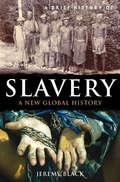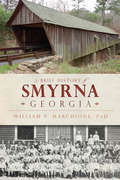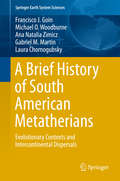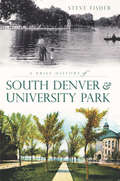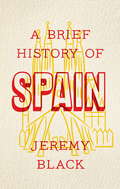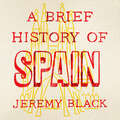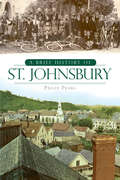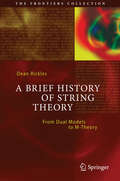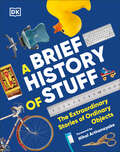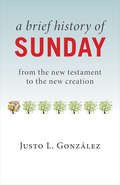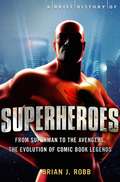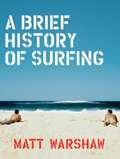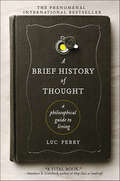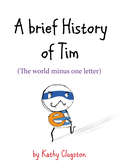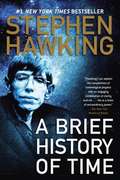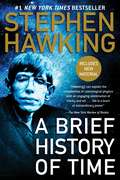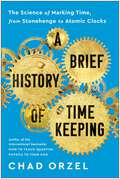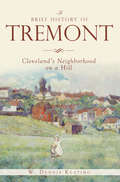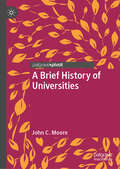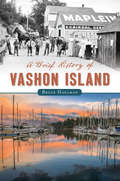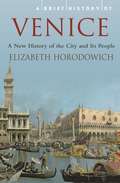- Table View
- List View
A Brief History of Slavery: A New Global History (Brief Histories)
by Jeremy BlackA thought-provoking and important book that raises essential issues crucial not only for understanding our past but also the present day.In this panoramic history, Jeremy Black tells how slavery was first developed in the ancient world, and reaches all the way to the present in the form of contemporary crimes such as trafficking and bonded labour. He shows how slavery has taken many forms throughout history and across the world - from the uprising of Spartacus, the plantations of the West Indies, and the murderous forced labour of the gulags and concentration camps.Slavery helped to consolidate transoceanic empires and helped mould new world societies such as America and Brazil. Black charts the long fight for abolition in the nineteenth century, looking at both the campaigners as well as the harrowing accounts of the enslaved themselves.Slavery is still with us today, and coerced labour can be found closer to home than one might expect.
A Brief History of Smyrna, Georgia (Brief History)
by William P. MarchioneThe dynamic city of Smyrna, Georgia, situated a scant fifteen miles northwest of Atlanta, has a fascinating history. In July 1864, two significant battles were fought within the confines of present-day Smyrna as General Sherman's Federal juggernaut converged on the "Gateway City" of Atlanta. The town was incorporated in 1872 with a population of fewer than three hundred residents and high expectations that rapid suburban development would ensue. It was the coming to the area of the aeronautics industry in the post-World War II period that finally generated sustained growth. Then, in the 1990s, the city reinvented itself through an aggressive urban renewal program spearheaded by its dynamic mayor, Max Bacon, and a progressive-minded city council. Join author William P. Marchione, PhD, as he recounts the fascinating history that created Smyrna.
A Brief History of South American Metatherians: Evolutionary Contexts and Intercontinental Dispersals (Springer Earth System Sciences)
by Michael O. Woodburne Francisco J. Goin Ana Natalia Zimicz Gabriel M. Martin Laura ChornogubskyThis book summarizes major aspects of the evolution of South American metatherians, including their epistemologic, phylogenetic, biogeographic, faunal, tectonic, paleoclimatic, and metabolic contexts. A brief overview of the evolution of each major South American lineage ("Ameridelphia", Sparassodonta, Didelphimorphia, Paucituberculata, Microbiotheria, and Polydolopimorphia) is provided. It is argued that due to physiological constraints, metatherian evolution closely followed the conditions imposed by global temperatures. In general terms, during the Paleocene and the early Eocene multiple radiations of metatherian lineages occurred, with many adaptive types exploiting insectivorous, frugivorous, and omnivorous adaptive zones. In turn, a mixture of generalized and specialized types, the latter mainly exploiting carnivorous and granivorous-folivorous adaptive zones, characterized the second half of the Cenozoic. In both periods, climate was the critical driver of their radiation and turnovers.
A Brief History of South Denver & University Park
by Steve FisherUniversity Park was founded in the 1880s when the University of Denver (Colorado Seminary) moved from downtown Denver to land donated by potato farmer Rufus Clark. The University, founded by Methodists, wanted to escape the urban blight of the city and build an oasis for education. Liquor production or consumption was not allowed, and though today the area has many pubs a number of home mortgages to this day contain old covenants forbidding the making or selling of spirits. Around University Park grew the town of South Denver, which was annexed to the city of Denver in the early twentieth century. For many years in the late 1800s the primary employer was the University of Denver, but over time others moved into the area for its attractive homes and well respected schools. The area has traditionally been upper middle class and has enjoyed one of the lowest crime rates in the city. At the geographic center of University Park is Observatory Park, named for the famous Chamberlain Observatory, built in the 1890s and still fully operational with popular public viewing nights. In the early part of the century Colorado Governor Henry Buchtel lived in the park, as did a number of famed early DU faculty such as Ammi Hyde, who beat the freshman boys in an annual foot race well into his 90's. The area boomed after World War II as many from other parts of the country who were stationed in Colorado chose to remain and make it their home. The area has remained prosperous and continues to grow, sharing in the overall success that the Denver metro area has experienced.
A Brief History of Spain: Indispensable for Travellers
by Jeremy BlackDespite being relatively brief, this very readable history covers environmental, political, social, economic, cultural and artistic elements, and is very open to regional variations and to the extent that the history of the peninsula and of its political groupings was far from inevitable. Its tone is accessible, supported by boxes providing supplemental information, and is perfect for travellers to Spain.
A Brief History of Spain: Indispensable for Travellers
by Jeremy BlackDespite being relatively brief, this very readable history covers environmental, political, social, economic, cultural and artistic elements, and is very open to regional variations and to the extent that the history of the peninsula and of its political groupings was far from inevitable. Its tone is accessible, supported by boxes providing supplemental information, and is perfect for travellers to Spain.
A Brief History of Spain: Indispensable for Travellers
by Jeremy BlackDespite being relatively brief, this very readable history covers environmental, political, social, economic, cultural and artistic elements, and is very open to regional variations and to the extent that the history of the peninsula and of its political groupings was far from inevitable. Its tone is accessible, supported by boxes providing supplemental information, and is perfect for travellers to Spain.
A Brief History of St. Johnsbury
by Peggy PearlTucked away in the dark forests of Vermont's NortheastKingdom, St. Johnsbury was mostly unbroken wildernesswhen first chartered in 1786. Swinging axes soon made wayfor the burgeoning split-level town, with stately Main Streethomes on St. Johnsbury Plain presiding in grandeur over thebustling commerce of Railroad Street below. Peggy Pearl bringsa decidedly human element to this comprehensive history,wandering the graves of Mount Pleasant Cemetery and bringingto life the stories of those tanners, cobblers, millworkers andbrick makers who made St. Johnsbury their home. With excerpts from vintage newspapers like the Caledonian-Record and the Farmer's Herald, Pearl unfolds the transformation from quiet mill town into picturesque manufacturing hub of Caledonia County.
A Brief History of String Theory: From Dual Models to M-Theory (The Frontiers Collection)
by Dean RicklesDuring its forty year lifespan, string theory has always had the power to divide, being called both a 'theory of everything' and a 'theory of nothing'. Critics have even questioned whether it qualifies as a scientific theory at all. This book adopts an objective stance, standing back from the question of the truth or falsity of string theory and instead focusing on how it came to be and how it came to occupy its present position in physics. An unexpectedly rich history is revealed, with deep connections to our most well-established physical theories. Fully self-contained and written in a lively fashion, the book will appeal to a wide variety of readers from novice to specialist.
A Brief History of Stuff: The Extraordinary Stories of Ordinary Objects
by DKLearn how 30,000 bath toys and the work of amateur beachcombers have helped scientists study ocean currents. Explore how the search for a death ray led to the creation of the microwave oven and ready-made meals. Discover the surprising link between sticky tape and the Nobel Prize. Uncover the extraordinary stories of ordinary objects in this perfect gift for curious minds. From the creators of the A Brief History of Stuff podcast and inspired by the incredible artifacts in the Science Museum Group Collection, this collection of entertaining essays reveals the fascinating history behind some of the most mundane items in our homes.
A Brief History of Sunday: From the New Testament to the New Creation
by Justo L. GonzálezIn this accessible historical overview of Sunday, noted scholar Justo González tells the story of how and why Christians have worshiped on Sunday from the earliest days of the church to the present. After discussing the views and practices relating to Sunday in the ancient church, González turns to Constantine and how his policies affected Sunday observances. He then recounts the long process, beginning in the Middle Ages and culminating with Puritanism, whereby Christians came to think of and strictly observe Sunday as the Sabbath. Finally, González looks at the current state of things, exploring especially how the explosive growth of the church in the Majority World has affected the observance of Sunday worldwide. Readers of this book will rediscover the joy and excitement of Sunday as early Christians celebrated it and will find fresh, inspiring perspectives on Sunday amid our current culture of indifference and even hostility to Christianity.
A Brief History of Superheroes: From Superman to the Avengers, the Evolution of Comic Book Legends
by Brian RobbA fascinating written exploration of the superhero phenomenon, from its beginnings in the depths of Great Depression to the blockbuster movies of today. For over 90 years, superheroes have been interrogated, deconstructed, and reinvented. In this wide-ranging study, Robb looks at the diverse characters, their creators, and the ways in which their creations have been reinvented for successive generations. Inevitably, the focus is on the United States, but the context is international, including an examination of characters developed in India and Japan in reaction to the traditional American hero. Sections examine: the birth of the superhero, including Superman, in 1938; the DC family (Superman, Batman, Wonder Woman and The Justice Society/League of America), from the 1940s to the 1960s; the superheroes enlistment in the war effort in the 1940s and 50s; their neutering by the Comics Code; the challenge to DC from the Marvel family (The Fantastic Four, Spider-Man, and The X-Men), from the 1960s to the 1980s; the superhero as complex anti-hero; superheroes deconstructed in the 1980s (The Watchmen and Frank Miller?s Batman), and their politicization; independent comic book creators and new publishers in the 1980s and 90s; superheroes in retreat, and their rebirth at the movies in blockbusters from Batman to Spider-Man and The Avengers.
A Brief History of Superheroes: From Superman to the Avengers, the Evolution of Comic Book Legends (Brief Histories)
by Brian RobbA fascinating written exploration of the superhero phenomenon, from its beginnings in the depths of Great Depression to the blockbuster movies of today. For over 90 years, superheroes have been interrogated, deconstructed, and reinvented. In this wide-ranging study, Robb looks at the diverse characters, their creators, and the ways in which their creations have been reinvented for successive generations. Inevitably, the focus is on the United States, but the context is international, including an examination of characters developed in India and Japan in reaction to the traditional American hero. Sections examine: the birth of the superhero, including Superman, in 1938; the DC family (Superman, Batman, Wonder Woman and The Justice Society/League of America), from the 1940s to the 1960s; the superheroes enlistment in the war effort in the 1940s and 50s; their neutering by the Comics Code; the challenge to DC from the Marvel family (The Fantastic Four, Spider-Man, and The X-Men), from the 1960s to the 1980s; the superhero as complex anti-hero; superheroes deconstructed in the 1980s (The Watchmen and Frank Miller’s Batman), and their politicization; independent comic book creators and new publishers in the 1980s and 90s; superheroes in retreat, and their rebirth at the movies in blockbusters from Batman to Spider-Man and The Avengers.
A Brief History of Surfing
by Matt WarshawMatt Warshaw knows more about surfing than any other person on the planet, as evidenced by The History of Surfing, Warshaw's definitive take on the sport. Now, he has honed that book into an abridged and excerpted edition for surfers everywhere. Each spread features a micro essay alongside an image capturing a slice of surf history, from Kelly Slater and the invention of the thruster to shark attacks and localism. Packaged in a small and chunky hardcover, A Brief History of Surfing deftly defines surf culture in an entertaining and irresistible volume with wide appeal.
A Brief History of The Third Reich: The Rise And Fall Of The Nazis (Brief Histories )
by Martyn WhittockBeginning in the broken aftermath of the First World War and the Treaty of Versailles that made German recovery almost impossible, Whittock tells not just the account of the men who rose to the fore in the dangerous days of the Weimar republic, circling around the cult of personality generated by Adolf Hitler, but also a convincing and personality-driven overview of how ordinary Germans became seduced by the dreams of a new world order, the Third Reich. The book also gives a fascinating insight into the everyday life in Germany during the Second World War and explores key questions such as how much did the Germans know about the Holocaust and why did the regime eventually fail so disastrously?
A Brief History of The Third Reich: The Rise and Fall of the Nazis (Brief Histories)
by Martyn WhittockThe abuse of power, genocide, the destruction of total war, unimaginable cruelty and the suffering of millions were all central features of Hitler's Nazi regime. Yet the Nazis were also highly successful in manipulating images and information: they mobilized and engaged vast numbers of people, caught the imagination of the young and appeared remarkably modern to many contemporary observers.Was the Third Reich a throwback to a mythical past or a brutally modern and technologically advanced state? Was Hitler a strong dictator who achieved his clear goals, or was his chaotic style of government symptomatic of a weak dictator, unable to control the complex and contradictory forces that he had unleashed? Was the Third Reich ruled by terror, or largely supported by a compliant German population? Was the genocide against the Jews a peculiarly German phenomenon, or a uniquely German expression of a terrible wider trend?Whittock explores these and other key questions, interrogating the views of different historians and drawing on a wealth of primary sources - from state-sponsored art to diaries, letters and memoirs of both perpetrators and victims - to provide an overview of the complex evidence. History should aim to put us firmly in touch with the lives of people living in the past and the issues they faced. Whittock never loses sight of the individuals whose lives were caught up in these extraordinary events, while also giving a lucid overview of the bigger picture.
A Brief History of Thought: A Philosophical Guide to Living (Learning to Live)
by Luc Ferry“Succinct and accessible” this international bestselling survey is “perfect for anyone who wants to dip their toe into the waters of philosophy” (Matt Haig, Washington Post).From the timeless wisdom of the ancient Greeks to Christianity, the Enlightenment, existentialism, and postmodernism, Luc Ferry’s instant classic brilliantly and accessibly explains the enduring teachings of philosophy—including its profound relevance to modern daily life and its essential role in achieving happiness and living a meaningful life. This lively journey through the great thinkers will enlighten every reader, young and old.“This superb primer is proof that philosophy belongs at the center of life.” —Publishers Weekly, starred review“Ferry's openness, energy, and charm as a teacher burst through on every page. However difficult the questions he poses, his eagerness to find answers, to justify philosophy as a way of life, is infectious.” —Wall Street Journal“For everyone from the man in the street to the man in the Acropolis—a fine introduction to philosophy and its fundamental relevance to living a meaningful life.” —Thomas Cathcart and Daniel Klein, New York Times–bestselling authors of Plato and a Platypus Walk into a Bar“This is a vital book. Luc Ferry rehabilitates the ancient question, ‘What is the best way of life?’ as though our lives depended on it.” —Matthew B. Crawford, New York Times–bestselling author of Shop Class as Soulcraft“No dry academic, Ferry restores to philosophy a compelling urgency.” —Booklist, starred review
A Brief History of Tim: The World Minus One Letter
by Kathy ClugstonRather than explaining our origins, A Brief History of Tim addresses our history and culture at the levelwe most deeply desire - the trivial. By simply removing one letter, the world is tweaked with immensely enjoyable results:For those who think contemporary art is a load of rubbish, there's the Tat Modern. Find out about the Ancient Geeks, nerdy types who spent far too much time doing maths.A Brief History of Tim is laugh-out-loud funny and will have you looking at the world through fresh eyes.
A Brief History of Time - Updated and Expanded 10th Anniversary Edition
by Stephen HawkingA Brief History of Time. This is the Famous book by Steven Hawking updated for the Tenth anniversary of its publication. Learn all you wanted to know about the universe and cosmology.
A Brief History of Time: From The Big Bang To Black Holes
by Stephen Hawking<P>A landmark volume in science writing by one of the great minds of our time, Stephen Hawking's book explores such profound questions as: How did the universe begin--and what made its start possible? Does time always flow forward? Is the universe unending--or are there boundaries? Are there other dimensions in space? What will happen when it all ends? <P>Told in language we all can understand, A Brief History of Time plunges into the exotic realms of black holes and quarks, of antimatter and "arrows of time," of the big bang and a bigger God--where the possibilities are wondrous and unexpected. With exciting images and profound imagination, Stephen Hawking brings us closer to the ultimate secrets at the very heart of creation of time and space. <P><b>A New York Times Bestseller</b>
A Brief History of Timekeeping: The Science of Marking Time, from Stonehenge to Atomic Clocks
by Chad Orzel2022 NATIONAL INDIE EXCELLENCE AWARDS WINNER — HISTORY: GENERAL ". . . inherently interesting, unique, and highly recommended addition to personal, professional, community, college, and academic library Physics of Time & Scientific Measurement history collections, and supplemental curriculum studies lists.&” —Midwest Book Review "A wonderful look into understanding and recording time, Orzel&’s latest is appropriate for all readers who are curious about those ticks and tocks that mark nearly every aspect of our lives." —Booklist &“A thorough, enjoyable exploration of the history and science behind measuring time.&” —Foreword Reviews It&’s all a matter of time—literally. From the movements of the spheres to the slipperiness of relativity, the story of science unfolds through the fascinating history of humanity&’s efforts to keep time. Our modern lives are ruled by clocks and watches, smartphone apps and calendar programs. While our gadgets may be new, however, the drive to measure and master time is anything but—and in A Brief History of Timekeeping, Chad Orzel traces the path from Stonehenge to your smartphone. Predating written language and marching on through human history, the desire for ever-better timekeeping has spurred technological innovation and sparked theories that radically reshaped our understanding of the universe and our place in it. Orzel, a physicist and the bestselling author of Breakfast with Einstein and How to Teach Quantum Physics to Your Dog continues his tradition of demystifying thorny scientific concepts by using the clocks and calendars central to our everyday activities as a jumping-off point to explore the science underlying the ways we keep track of our time. Ancient solstice markers (which still work perfectly 5,000 years later) depend on the basic astrophysics of our solar system; mechanical clocks owe their development to Newtonian physics; and the ultra-precise atomic timekeeping that enables GPS hinges on the predictable oddities of quantum mechanics. Along the way, Orzel visits the delicate negotiations involved in Gregorian calendar reform, the intricate and entirely unique system employed by the Maya, and how the problem of synchronizing clocks at different locations ultimately required us to abandon the idea of time as an absolute and universal quantity. Sharp and engaging, A Brief History of Timekeeping is a story not just about the science of sundials, sandglasses, and mechanical clocks, but also the politics of calendars and time zones, the philosophy of measurement, and the nature of space and time itself. For those interested in science, technology, or history, or anyone who&’s ever wondered about the instruments that divide our days into moments: the time you spend reading this book may fly, and it is certain to be well spent.
A Brief History of Tremont: Cleveland’s Neighborhood on a Hill (Brief History)
by W. Dennis KeatingFor almost two centuries, the historic Tremont neighborhood has rested on a bluff overlooking Cleveland's industrial valley. The sleepy farming community was transformed in 1867, when Cleveland annexed it. Factories attracted thousands of emigrants from Europe, and industrialization gave rise to a class of wealthy businessmen. After the city prospered as a manufacturing center during World War II, deindustrialization and suburbanization fueled a huge population loss, and the neighborhood declined as highways cut through. The 1980s marked the beginning of the rebirth of the cultural treasure Tremont became. Author W. Dennis Keating chronicles the challenges and triumphs of this diverse and vibrant community.
A Brief History of Universities
by John C. MooreIn this book, John C. Moore surveys the history of universities, from their origin in the Middle Ages to the present. Universities have survived the disruptive power of the Protestant Reformation, the Scientific, French, and Industrial Revolutions, and the turmoil of two world wars—and they have been exported to every continent through Western imperialism. Moore deftly tells this story in a series of chronological chapters, covering major developments such as the rise of literary humanism and the printing press, the “Berlin model” of universities as research institutions, the growing importance of science and technology, and the global wave of campus activism that rocked the twentieth century. Focusing on significant individuals and global contexts, he highlights how the university has absorbed influences without losing its central traditions. Today, Moore argues, as universities seek corporate solutions to twenty-first-century problems, we must renew our commitment to a higher education that produces not only technicians, but citizens.
A Brief History of Vashon Island (Brief History)
by Bruce HaulmanReachable only by ferry, Vashon Island is a breathtaking rural retreat from the bustling activity of nearby Seattle and Tacoma. The island's first inhabitants, the sx???babš, took advantage of its evergreen forests and rich marine resources. In 1792, George Vancouver was the first Anglo to discover the island and named it after Captain James Vashon. By the late 1800s, the first white settlers had established farms and greenhouses that supplied nearby cities with berries, tomatoes and cucumbers. Ferries drove development in the later half of the century, introducing new industries and tourism to the area. While both influenced by and isolated from the mainland, the island developed its own unique character treasured by locals. Merging human and natural history, author Bruce Haulman presents the rich heritage of this thriving community.
A Brief History of Venice
by Elizabeth HorodowichIn this colourful new history of Venice, Elizabeth Horodowich, one of the leading experts on Venice, tells the story of the place from its ancient origins, and its early days as a multicultural trading city where Christians, Jews and Muslims lived together at the crossroads between East and West. She explores the often overlooked role of Venice, alongside Florence and Rome, as one of the principal Renaissance capitals. Now, as the resident population falls and the number of tourists grows, as brash new advertisements disfigure the ancient buildings, she looks at the threat from the rising water level and the future of one of the great wonders of the world.
